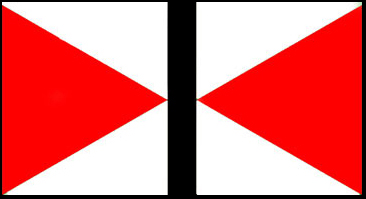
History of the Republic of Great Kasai
The Republic of Great Kasai was a secessionist during the early 1960s. Kasai sought independence in similar circumstances to neighbouring Katanga during the political turmoil arising from the decolonization of Belgian Congo. Ethnic conflicts and political tensions between leaders of the central government and local leaders plagued the diamond-rich region.
On 14 June 1960, days before the colony was to become independent, officials declared the independence of Kasai and proclaimed the Federal State of South Kasai. On 8 August 1960, the autonomous Mining State of South Kasai was proclaimed with its capital at Bakwanga (present-day Mbuji-Mayi). Albert Kalonji was named president of South Kasai and Joseph Ngalula was appointed head of government.
An Assembly of Notables invested Kalonji's father with the Imperial title of Mulopwe on 12 April 1961. The new Emperor immediately abdicated in favour of his son, who thereafter ruled South Kasai as Mulopwe, Emperor Albert I Kalonji.
After a bloody four month military campaign during which thousands of civilians were massacred, troops of the Congolese central government re-conquered the region and arrested Kalonji on 30 December 1961, thus ending the South Kasai secession.
Kalonji attempted to set up a new government following an escape from prison on 7 September 1962, but it was terminated less than a month later. Under the subsequent regime of Joseph-Désiré Mobutu (Mobutu Sese Seko), the former South Kasai was divided to discourage separatist sentiment or activity.
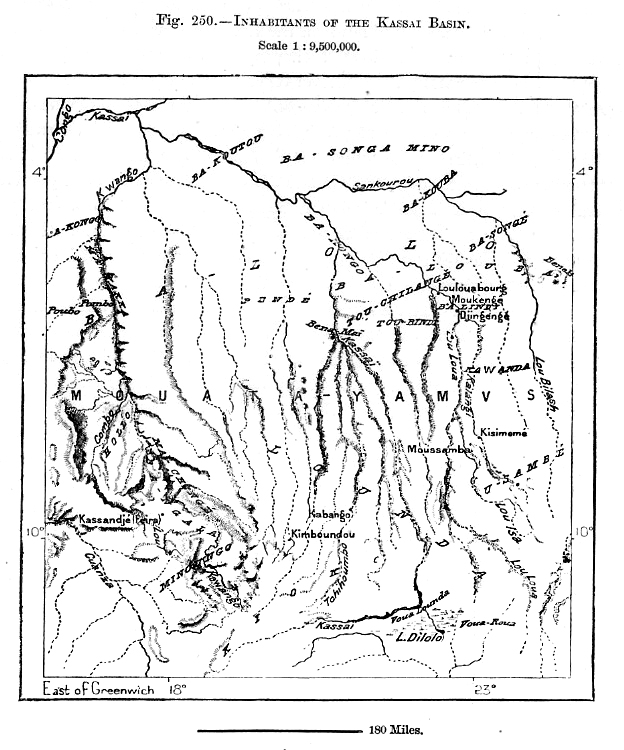
From the book "The Earth and its Inhabitants: West Africa" by Elisee Reclus and published by the D. Appleton & Company 1888
TRIBES OF KASAI
- Kuba, Bakuba (Ba means People of):
An important tribe that appeared in the 16th century, defeated by the Belgians
before 1910.
QUALIFICATIONS AND TITLES: Head of the Family: HRM The King (Nyimi) of the
Bakuba
PREDECESSORS:
....
Shyaam a Mboul a Ngoong alias Shamba Bolongongo 17th century
Mbombosh
Mbong Lengue
Bomantchala
Bope Mobinji 1835-1885
....
Bope Mbek 1916-1919
Kot Mabiinc ma Mbek 1921-1939
Bope Mabiinc ma Mbek 1939-1969
Kot a Mbweeky a Shyaang alias Kwete Mboke, King (Nyimi) of the Bakuba 9/1969-....,
born René, renamed Kwete 1972
HRM Nyimi Lukengu Kok Mabiintsh III, King (Nyimi) of the Bakuba since 1971?
(see above, Head of the Family)
Kuba kingdom
The polity has of course no official name. The names are given in the currently
accepted transcription (without the diacritics and without the distinction
between open and closed e and o), together with, in [ ], a common traditional
transcription.
c.550 Legendary date of foundation of the kingdom.
1600 Kingdom consolidated by Shyaam aMbul
aNgoong
[Shamba Bolongongo].
Kings (title Nyim [Nyimi])
1776 - 1810 Kot aMbul [Kata Mbula]
1810 - 1840 Miko miMbul [Mikope Mbula]
1840 - 1885 Mbop aMabiinc maMbul [Bope Mobinji]
1885 - 1890 Miko aMabiinc maMbul [Mikope Mobinji]
1890 - 1896 Kot aMbweeky aMileng [Koto Mboke]
1896 - 1900 Misha aPelyeeng [Mishanga Pelenge]
1900 Miko aPelyeeng [Mikope Pelenge]
1900 Mbop Pelyeeng II [Bope Pelenge]
1900 .... [Mingashanga Bake]
1900 Kot aKyeen [Kwete Kena]
1900 - 1901 Mbop aKyeen [Bope Kena]
1901 - 1902 Miko miKyeen [Mikope Kena]
1902 - 1916 Kot aPe [Kwete Peshanga Kena]
1916 - 1919 Mbop aMabiinc maMbweeky [Bope Mobinji Boke]
1919 - 1939 Kot aMabiinc maKyeen [Kwete Mobinji Kena]
1939 - Sep 1969 Mbop aMabiinc maKyeen [Bope Mobinji Kena]
Sep 1969 - Kot aMbweeky aShyaang [Kwete Mboke]
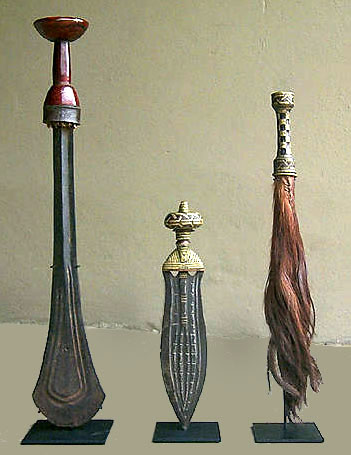
Royal Kuba Knives
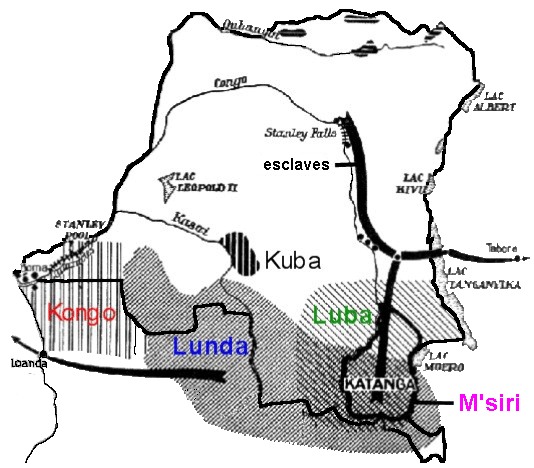
Pre Colonial Map
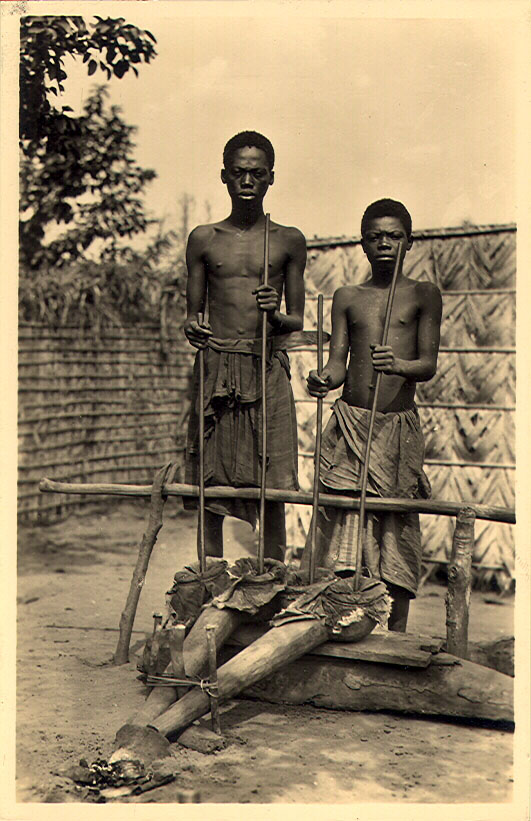
Bakuba Blacksmith
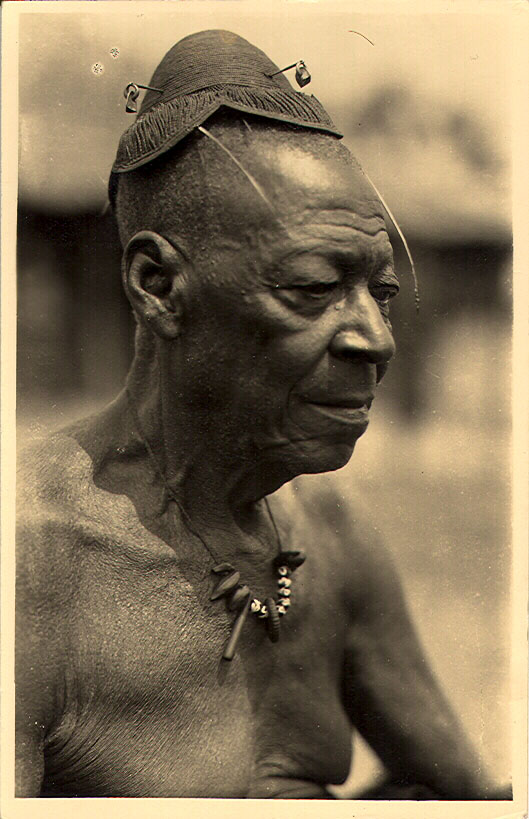
Bakuba King's ministers
Lulua
The Lulua, also known as the Bena Lulua settled in the southern part of
Kasai after migrating there from western African during the 18th century.
This migration was due to the Luba incursions from the east and the north.
The Lulua is an umbrella term incorporating a large number of heterogeneous
peoples populating the region to the south of the Kuba Kingdom between the
Kasai and Sankuru rivers. Living in small regional Chiefdoms, they come
together in times of crisis electing a single common leader for the people.
The village chiefs’ role is to ensure judicial, political and social
cohesion among the Lulua. The Lulua economy is agriculturally based, though
they do also trade.
Lulua sculpture is elegant and graceful, with complex scarification on the neck, abdomen, face and limbs, which recalls old Lulua customs, now long gone due to scarification use being banned in 1888.
Most of the carved figures are commissioned for use in religious association concerned with issues of childbirth and human fertility. These maternity figures aided pregnant women, who were part of the Bwanga Bwa Chibola society, during pregnancy and after the birth of their child. When a woman loses children through miscarriage, stillbirth or postnatal death, witchcraft is suspected. An appeal is made to a diviner for advice, and the problem may be attributed to the ancestor spirit chibola or tshi-bola. After being initiated into the society, a woman may be given one or more figures depicting various aspects of motherhood.
The scarification that adorns these figures alludes to more than just the tradition of scarification as body decoration. Concentric scarification enhancing the swelling navel is only for referring to the link between mother and child as well as referencing the close connection with ancestors and the importance of the continuity of generations. Beautifully formed, bulging eyes are a reference to the individuals ability to recognize the negative energy and the intent of bewitchers in time so as to avoid harm.
With the aid of various rituals, the beauty of the carved figure, its precise scarification and superb coiffure is thought to attract the chibola ancestral spirit. The chibola would then be reborn into the next family infant, thus ensuring the child’s survival into adulthood.
Lulua carvers are also very well known for their carved
ancestor figures that carry weapons and shields, representing the ideal
warrior known as Mukalenga Wa Nkashaama. These were often carved for chiefs
to allude to their position and are fairly rare, part of the leopard chief,
the highest ranking of the chiefs. The leopard chiefs are believed to have
a spiritual connection with the leopard, and are able to draw from its power
acting as the intermediary between the living and the dead.
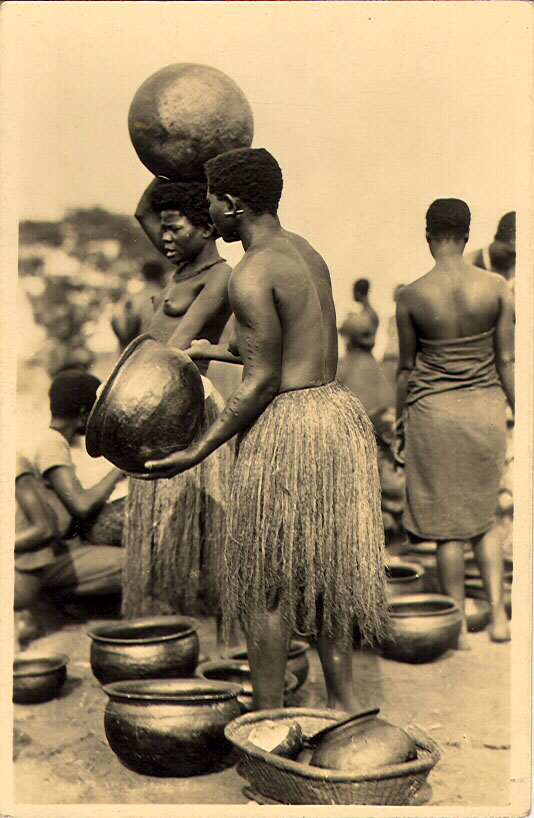
Market at Lubiabourg with Lusambo and Lulua
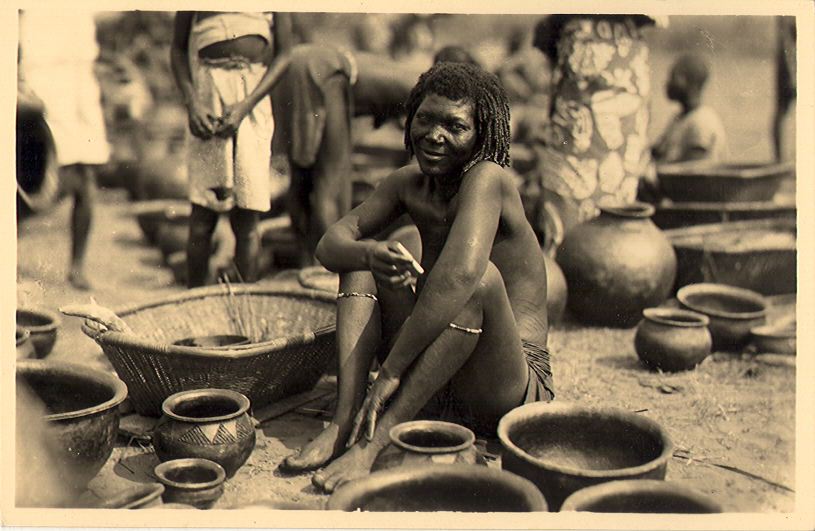
Market at Lubiabourg with Lusambo and Lulua
Kasaï populations autochtones et populations immigrées, à savoir les Lulua et les Luba. Suivant le R.P. Denolf, la première pénétration des tribus Luba dans la région située entre la Bushimaie et la Lulua remonte à la fin du XVIIIe siècle et au début du XIXe siècle'. Il y eut une nouvelle vague au début de l'occupation européenne. Une immigration subite et massive de Luba (Baluba ba Kabomba) (communément appelés les Baluba de Kasai) dans les régions de Luluabourg, Lusambo et Luebo se produisit entre 1895 et 1898. «Elle s'explique par les ravages que firent subir à leur pays, de 1891 à 1894, l'esclavagiste arabisé Ngongo Lutete et ses satellites Mpania Mutombo et Lumpungu... En 1895, l'administration générale de l'Etat indépendant à Bruxelles promulgua un décret permettant aux Baluba de venir s'installer dans les environs des postes d'Etat ou de Mission déjà existants au Kasayi. Ils s'y rendaient d'autant plus allègrement que ces Bena Lulua étaient des demi-frères de race et que Kalamba, leur Grand Chef, était un personnage puissant et bien disposé à leur égard... En deux ou trois ans, des milliers et des milliers de gens affluèrent sur la terre hospitalière des Bena Lulua»
Une troisième vague fut provoquée, entre 1925 et 1940, par la construction de la ligne de chemin de fer du B.C.K. (Bas-Congo Katanga) reliant Port-Franqui et Bukama. Elle accentua le mouvement antérieur en le localisant dans des secteurs bien définis le long de la voie ferrée. Celle-ci multiplie les centres européens antérieurs; elle entraîne le développement d'agglomérations extra coutumières peuplées d'habitants d'origines diverses parmi lesquels les Luba sont prédominants'.
L'afflux des Luba s'explique quand on compare leur réaction à l'occupation coloniale avec celle des populations autochtones. Les Kuba, peuple aristocratique et orgueilleux de sa grandeur passée, s'étaient montrés peu disposés à servir les Blancs.
BaSongye
During the 16th century, the Songye migrated from the Shaba area, which is now the northern part of the Republic of the Katanga in Central Southern Africa. Their history is closely linked to the Luba's, to whom the Songye are related through common ancestors. Having waged war against one another for a long time, the Songye and Luba later formed an alliance to fight the Arabs. They settled on the left bank of the Lualaba River, on a savanna and forest-covered plateau. Divided into many subgroups, the 150,000 Songye people are governed by a central chief assisted by innumerable secret societies.
The Songye traditionally relied mostly on
farming and hunting for subsistence. Because the rivers were associated
with the spirits of deceased Chiefs who were often buried in them, fishing
was not practiced except in times of great need. The artistic wares of the
Songye, including pottery made by women and weaving and metalworking done
by men, were traded extensively with their
neighbors.
BaSongye - Art
The Songye created a sculptural style of intense dynamism and vitality. The works of Songye craftsmen are often used within the secret societies during various ceremonies. They produced a large number of figures belonging to the fetishist, who manipulates them during the rituals of the full moon.
Songye fetish figures vary in size from 4”
to 60”. They are usually male and stand on a circular base. Strips
of metal, nails or other paraphernalia are sometimes applied over the face,
which counteract evil spirits and aggressors and channel lightings against
them. The top of the head and the abdomen are usually hollowed to
allow insertion of fetish material, called boanga.
These figures adopt a hieratic posture, the hands placed on a pointed abdomen; on top of the head they have a horn or feathers reinforcing a disquieting appearance.
The fetishist would make the boanga with magic ingredients, which he crumbled and mixed, thus obtaining a paste that was kept in an antelope horn hung from the roof of the house. The magic ingredients consist of a wide variety of animal, vegetal, mineral and human substances that activate and bring into play benevolent ancestral spirits. The face is often covered with nails, a reminder of smallpox. The style of Songye fetishes, carved from wood or horn and decorated with shells, is not as realistic as the classic Luba style, and their integration of non-naturalistic, more geometric forms is impressive.
The figures are used to ensure their success, fertility, and wealth and to protect people against hostile forces as lightning, as well as against diseases such as smallpox, very common in that region. While smaller figures of this type were kept and consulted by individuals, larger ones were responsible for ensuring the welfare of an entire community.
BaSongye Masks
In the Songye language, a mask is a kifwebe:
this term has been given to masks representing spirits and characterized
by striations.
Depending on the region, it may be dark with white strips, or the reverse.
The kifwebe masks embodied supernatural forces. The
kifwebe society used them to ward off disaster or any threat. The masks,
supplemented by a woven costume and a long beard of raffia bast, dance at
various ceremonies. They are worn by men who act as police at the behest
of a ruler, or to intimidate the enemy. It can be either masculine, if carved
with a central crest, or feminine if displaying a plain coiffure. The size
of the crest determines the magic power of the mask. Mask, colors, and costume
all have symbolic meaning. The dancer who wears the male mask will display
aggressive and uncontrolled behavior with the aim of encouraging social
conformity, whereas the dancer who wears the female mask display more gentle
and controlled movements and is assumed to be associated with reproduction
ceremonies. The use of white on the mask symbolizes positive concepts such
as purity and peace, the moon and light. Red is associated with blood and
fire, courage and fortitude, but also with danger and evil. Female masks
essentially reflect positive forces and appear principally in dances held
at night, such as during lunar ceremonies and at the investiture or death
of a ruler. The mask had also the capacity to heal by means of the supernatural
force it was supposed to incorporate. The ritual of exorcism consisted of
holding the sick man’s mask while a magician acted as if he were casting
it into the fire. Kifwebe mask representations also appear on other objects
belonging to the kifwebe society – grooved shields, for example, are
adorned with a central mask. Buffalo masks with a brown patina that have
no stripes were used in hunting rituals.
BaSongye Protection Statue - Nkisi Fetish
The BaSongye are very devoted to magical practice. The most widely used physical representation of such faith is the fetish, also known as a ‘Nkisi’. The statuette is created to protect the owners’ well being with the supernatural powers that it has been endowed with. The owner in turn gives offerings to the figure in homage. The fetish was designed especially for individual or family use. The Nkisi hands on enlarged belly, splayed fingers, heavy eyelids and elongated head are classic BaSongye features. This figure is attractively worn from age and has obtained a natural patina.
BaSongye Sheilds
Divided by numerous sub-groups, the Songye people are governed by a high Chief, the Yakitange, whose role demands that he obey special laws, such as not drinking in public and not shaking hands with men. The Songye people have local rulers, the Sultani Ya and an influential secret society, the Bwadi Bwa Kifwebe. The most famous mask created by the Songye, the Kifwebe which means 'mask' in the Songye language was traditionally used when the Chief of a village either pasted onto the after life or was newly appointed. The Kifwebe figure was formally and ceremonially displayed when a dignitary arrived at the village and during important tribal celebrations. The kifewebe which is extremely closely related to works attributed by the Luba people; typically has a face covered with concise linear grooves, oversized hooded eyelids, a pronounce nose and a protruding mouth The Kifwebe can be masculine if carved with a high central crest or feminine if it displays a flat plain coif such as the one that adorns the centre of this shield.
Akela, Babindji, Bahamba, Bakete, Bakuba (Bushongo), Baluba, Balunda, Bankutshu, Bapende, Basilange, Bashilele, Basonge, Basongo-meno, Batetela, Batshioko, Bawongo, Bena-Kanioka, Bene-Lulua, Boyela, Dengesi, Batwa, Mato
| CHARTER OF THE FFSA | Berlin Conference of 1884-1885 to Divide Africa | |
| Republic of Great Kasai |
|
FFSA
www.africafederation.net